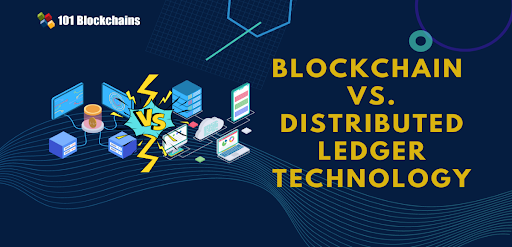
Blockchain and distributed ledger technology have become increasingly popular buzzwords over the past few years, especially as discussions around cryptocurrencies like Bitcoin dominate the business news cycle.
But, what exactly do blockchain and distributed ledger technology do?
What’s the difference between blockchain and distributed ledger technology?
This detailed guide will answer all of these questions about blockchain vs distributed ledger technology and look at their definitions, advantages, and future to help you decide which one is more suitable for your needs.
So without any further delays, let’s get started with our first question
What is blockchain technology?
Blockchain was invented in 2008 as an open-source code by Satoshi Nakamoto, a software developer. Since then, it has been used for many applications, including cryptocurrency, smart contracts, and supply chain management systems.
Currently, blockchain is described as a distributed database that maintains a continuously growing list of data records secured from tampering and revision.
Blockchain technology allows a secure, transparent, and tamper-proof way of storing data. It’s essentially a digital ledger that can be used to record anything of value, from financial transactions to votes.
The beauty of blockchain technology is that it requires no middleman – the database is maintained by a network of computers, meaning there’s no need for a third party to verify or approve transactions. This makes it an ideal solution for industries such as finance and logistics that require transparency and trust.
Blockchain technology has a variety of applications beyond cryptocurrency, including tracking ownership, digital assets, and contracts. It could also create more secure and efficient data storage and sharing systems.
Blockchain is an immutable public ledger that records digital transactions. The blockchain is shared among all nodes participating in a system. This means that everyone on a network can see every transaction ever made on that network, making it transparent at any given time.
What is DLT (Distributed Ledger Technology)?
With the advent of digital currencies and online transactions, technology needs to maintain a digital ledger of all these transactions in a secure and tamper-proof manner. This is where distributed ledger technology comes in.
Distributed ledger technology (DLT) is a database that allows for secure, shared, and decentralized management of digital data or information. It is often compared to a traditional database in that it maintains records of data or information. However, unlike a conventional database, DLT relies on distributed consensus mechanisms to ensure that the data or information stored on the ledger is accurate and up-to-date.
Some of the benefits of distributed ledger technology include improved security, reduced costs, faster transactions, and increased efficiency. Compared to traditional databases, distributed ledgers are much harder to hack or tamper with because they do not have a single point of failure.
In addition, since there is no centralized server that manages data on a DLT network, it is more difficult for hackers to gain access to information stored on a DLT network because they would need to hack into each node individually to gain access.
This means that even if one node is hacked, other nodes will still be able to operate normally without being affected by any data tampering from an outside source.
What is the difference between blockchain technology and Distributed Ledger Technology?
The main difference between blockchain technology and distributed ledger technology is that blockchain is an immutable and decentralized database. In contrast, a distributed ledger is simply a distributed database spread across a network.
Concerning immutability, blockchain employs cryptographic hashing, which allows information to be recorded chronologically and publicly. This makes it impossible to tamper with data that has already been stored on the blockchain, as doing so would require changing the hash of all subsequent blocks.
On the other hand, Distributed Ledger Technology (DLT) is a decentralized database that can be shared across a network of computers. It is possible for information stored on a DLT to be altered or deleted, as doing so would only require changing one record out of millions in its database.
A blockchain is an immutable, decentralized database that can be shared across a network of computers. At the same time, DLT is simply a decentralized database that can be shared across a network of computers. They are not entirely different technologies as they both have their advantages and disadvantages.
Pros of blockchain technology
1. Increased security and transparency
The blockchain is a distributed database not stored in one location. There is little or no risk of hackers accessing the data or tampering with the information. Transactions on the blockchain are also public, which means that everyone involved in the transaction can see what happened. The decentralization of data provides a high level of transparency and trust.
2. Reduced costs and faster transactions

The biggest pro of blockchain technology is that it has the potential to reduce costs and transaction times drastically. For example, banks typically charge high fees for international money transfers. However, blockchain technology significantly reduces these expenses.
Additionally, transaction times could be significantly reduced since blockchain eliminates the need for intermediaries like banks or credit card companies. In other words, transactions can be processed directly between two parties without a third-party processing time delay. Consequently, blockchain holds great promise for reducing both cost and friction in many different types of transactions.
3. Faster and simpler processes
A blockchain can process transactions faster than traditional models because it does not need third-party intermediaries. Additionally, smart contracts make many business processes more straightforward and more efficient.
For example, a land registry on a blockchain could reduce fraud since everyone involved in an ownership transfer can see precisely who owns what at any given time. This makes buying or selling property much more accessible. Ultimately, blockchain has a lot of potential for streamlining existing business processes and enabling new ones that were previously impossible or impractical due to high costs or lack of transparency.
Cons of blockchain technology
1. Blockchain is a decentralized technology
it can be tough to maintain performance and scalability as the number of transactions and users increases. Due to its decentralized nature, there is no central authority overseeing the blockchain, making governance and decision-making more difficult. There is no single point of control or failure, and if something goes wrong with the network, it can be tough to fix it because every node on the network must be updated for things to go back to normal.
2. The high energy consumption
Bitcoin and other cryptocurrencies require a vast amount of energy to be mined. In fact, it has been estimated that the annual energy consumption of Bitcoin alone is equivalent to that used by Austria. This is bad for the environment and could lead to higher energy costs for consumers.
3. A growing list of concerns about privacy

There are fears that some blockchain applications could lead to a loss of privacy for users. For example, a blockchain-based social media platform where users can earn cryptocurrency by selling their data and disclosing their activities online. This area requires more research and development for people’s personal information while still allowing them to benefit from sharing data online.
Pros of distributed ledger technology
1. Increased Security
Because DLT networks are spread across multiple nodes, they are less vulnerable to hacking or fraud than traditional systems. This makes DLT an attractive option for handling sensitive data or high-value transactions. Also, since there is no single point of failure in a distributed ledger system, it is nearly impossible to destroy information stored on a blockchain network.
2. Improved Traceability and Transparency
Because DLT is a distributed system, it is easy to track information moving through each node on a network. This makes DLT ideal for businesses that want to keep an accurate record of their supply chain or monitor transactions in real-time. Additionally, because all data stored on a blockchain network is transparent, users can verify its authenticity without fear of tampering.
3. Lower Costs
The decentralized nature of DLT networks means there are no intermediaries required to verify transactions, which can significantly reduce costs associated with third-party services like credit card processors or payment gateways. For example, a recent report by Santander estimated that blockchain technology could save banks up to $20 billion annually through reduced infrastructure costs and improved operational efficiency.
Cons of distributed ledger technology
Difficult to Change or Reverse Transactions
Once a transaction is recorded on a blockchain, it is incredibly difficult to change or reverse. This could be problematic if, for example, an error is made or someone fraudulently alters a transaction.
2. Increases Latency Time

The more transactions that need to be processed or confirmed on a blockchain network, the longer it takes for a transaction to be completed and recorded imminently across every node within that network. This can sometimes lead to increased latency time as more and more people can access and use that technology simultaneously.
3. Scalability
The current blockchain infrastructure cannot handle the high volume of transactions required for large-scale applications such as global supply chains, financial services, or other industries that require instant transaction processing times. As a result, many big businesses are moving away from distributed ledger technology and looking for shared databases that allow faster transaction processing times and greater scalability.
The future- platforms combining features of both technologies Distributed Ledger Technology and blockchain technology
While both blockchain technology and distributed ledger technology have distinct advantages, there is a growing consensus that the two platforms can complement one another. Combining the best features of both technologies may be possible to create a more efficient, secure, and user-friendly system.
For example, blockchain technology could create a decentralized network of computers, while distributed ledger technology could be used to manage and store data. You can hire blockchain developers in India to create a more efficient system that is less vulnerable to tampering or attack. In addition, by using both technologies, it would be possible to create a more scalable and flexible platform.
As a result, the future of both technologies may lie in their ability to work together.
Read Also: What are altcoins? Are they a good investment?
Conclusion
Blockchain and Distributed Ledger Technology are two of the most talked-about technologies in recent years. They both have the potential to revolutionize how business is done, but they are often confused with each other. In this article, we’ve outlined the key differences between these two technologies so that you can decide which one is right for your business.
That’s all for today. We hope you find this blog post useful and informative; If you need any assistance, you can get in touch with a blockchain development company in India.
Kindly share this blog with your friends, and don’t forget to mention your suggestion in the comment section below.
We will catch you in the next post with another interesting topic.
Till then, keep working hard and do not forget to follow us.



